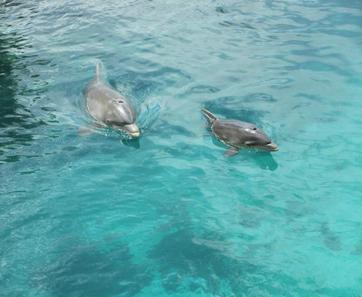For more information, please
Paulina, from El Paso, TX shown above. She has participated in several dolphin therapy programs and her parents report: "After autism dolphin therapy she is calmer & more social. Her speech, eye contact and attention span have also improved."
How Dolphins Help Us
Aquatic therapy has long understood that being in the water has a therapeutic effect on people with varying types of disabilities (McKinney, A; Wolf, R.; 2001). Being in the water allows people that are in wheelchairs, freedom in movement otherwise not experienced. To this benefit include dolphins. Dolphins have been cited as having special capabilities that enhance healing potential in people with disabilities (Johnson, L.; Bourne, R.).
Dolphin Therapy refers to a type of treatment for people with and without disabilities that uses dolphin interaction as well as direct sonar application as a means to rectify or lessen the disability.
Dolphin assisted therapy dates back to the 1950s and the work of Dr. John Lilly, who studied the effects of dolphins on individuals with disabilities (McKinney, A; Wolf, R.; 2001). In the late 1980's, Dr. Stephen Joszef, co-founder of Living from the Heart also carried out a neurological research study that shed valuable light on the mechanism of action for this most delightful and effective therapy.
David Cole and Dr. Jozsef found through their biofeedback research that various interesting things happen in our brain after direct exposure to dolphin sonar. First thing that happens is that our brain wave pattern drops from an active state (beta brain waves) down to a meditative brain wave pattern (alpha and sometimes even theta brain waves).
Research conducted by the Aquathought Foundation found an observable period of hemispheric synchronization which is an uncommon neurological state. It is believed this synchronization increases learning ability and heightens awareness.
There is a wide variety of reports on people who benefit from this therapy. People with non-verbal or communicative disorders have found positive results in working with dolphins. Children with special needs including autism, asd’s, pdd’s, cerebral palsy, etc., are a unique focus to many programs. There has also has been recent research for people experiencing depression or anxiety. This spans young and old, and a variety of illnesses, sicknesses, or diagnoses.
Perhaps the most profound changes from dolphin therapy are in children with autism and similar challenges.
People have observed the following dolphin therapy benefits:
-90% become calmer and more focused and attention span is increased
-after dolphin therapy 80% of children with autism began pronouncing words and expressions and communicating better in general
-75% of the parents of children with autism indicated an improvement of eye contact, smiling, laughing and touching
-75% have improved emotional behavior, confidence and self-esteem after dolphin therapy.
Why dolphins? Dolphins measure 8 to 10 feet in length; weigh an average of 400 pounds, swim up to 35 miles per hour. Dolphins are gentle in demeanor, graceful in the water, and appear friendly and communicative (McKinney, A; Wolf, R.; 2001) and have the capability to heal through presence and interactions.
The exploration of stress reduction, by specialists in alternative treatment, has lead the way to current dolphin-human interaction research. Researchers have found that dolphin therapy aids in reducing stress and increasing relaxation, alleviating depression, boosting production of infection fighting t-cells, stimulating production of endorphins and hormones, enhancing recovery, and reducing pain.
Or call us at:
(303) 512-3614 or
(970) 281-4331 -English/ Español
 | ||||
Living From The Heart, The Dolphin Experience, (303) 512-3614, P. O. Box 865, Morrison, Colorado 80465,macy@lfhdolphinexperience.org







